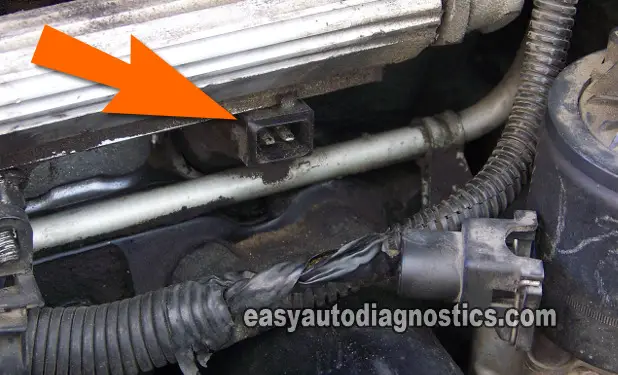Checking Fuel Injector Pulse

OK, I decided to tackle the fuel injector and its circuits first for my next test. The very first thing I need to know is if the fuel injector is getting power (12 Volts) and the activation signal from the PCM.
The easiest and fastest way to find out is by attaching a fuel injector Noid light to the fuel injector connector and then have a helper crank the engine (while I observe the Noid light) to see if it flashes ON and OFF. I pulled out my fuel injector Noid lights and found the one that fits into the type of fuel injector connector the Quad 4 engine uses (they're Bosch style connectors).
Well, the result was that the fuel injector Noid light did flash ON and OFF (as my buddy cranked and started the engine), indicating that the fuel injector was receiving both power (12 Volts) and the activation pulses from the PCM.
Now, just to make sure that these flashes looked/were normal, I unplugged the #3 fuel injector and tested it with the Noid light too. I needed to see the results of the #3 fuel injector pulses on the Noid light so that I could compare them to the #4 Injector Noid light test results.
And the length and intensity of the flashes (of the Noid light) were the same for both fuel injectors.
This test only eliminates/condemns the fuel injector circuits and with the results I obtained in this case, I could completely eliminate them as the source of the problem. Now I needed to test the fuel injectors themselves and the next sub-heading explains how I did this.
What if I had gotten no Noid light flashes? Then this result would've let me know, beyond a shadow of a doubt, that the misfire was due to an electrical fault/short in the circuits of the fuel injector or PCM.
This result would've also told me that I could completely eliminate all of the components that make up the ignition system (ignition module, ignition coil, ignition coil housing cover, spark plug boots, spark plugs, etc) and the fuel injector itself as the source of the Random Misfire P0300 code and misfire condition.
What if the Noid light would have just lit up bright without flashing ON and OFF? This result I've seen a few times and usually has indicated that the PCM (Powertrain Control Module=Fuel Injection Computer) has fried internally. Doesn't happen a lot.
What if the Noid light had NOT flashed ON and OFF at all? This is an indication that the fuel injector is either getting power (12 Volts) but not the activation signal from the PCM. Or not getting power but the activation signal is present.
If this had been the result of my Noid light test, then I could've eliminated the ignition system and the fuel injector as the cause of the misfire condition and concentrated on finding out what was wrong with these circuits.
Resistance Testing The Fuel Injectors

There are so many ways to test fuel injectors that range from very complicated/technical ways to some very simple tests. The method I used on this occasion is one of the simplest and most effective ways of testing for bad fuel injectors.
I did a very simple resistance test of several fuel injectors and compared the Ohms readings of each to each other. If the #4 fuel injector is good, then its Ohms reading will be almost the exact same as the others. If its bad, then its Ohms reading will be way greater or smaller than the others.
I pulled out my multimeter from my toolbox and measured the resistance of the #4, #3, and #2 fuel injectors to see what resistance reading would pop up on my multimeter. I don't remember the fuel injector resistance value (and it doesn't matter) but the resistance values were near identical to each other.
So with these values in hand, I now knew that the problem did not lie in a bad fuel injector. So, now the next thing I needed to do was check the engine compression to see if maybe cylinder #4 was having mechanical problems.
So what if the resistance (Ohms) value had been different from the other fuel injectors? Then this result would tell me that the #4 fuel injector is indeed bad. Now, since up to this point I have done the basic spark tests, the resistance (Ohms) results would be a clear indication that replacing the fuel injector would solve the misfire condition.
What's Next?
Up until this point, all of my test results had helped me to eliminate several components and systems. Now I needed to check the engine's mechanical condition with a compression test. Let's turn the page and see what results I got from this test.
